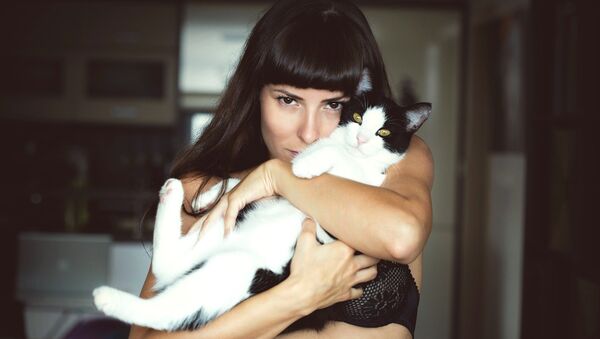Ailurophiles often jest that their beloved pet cats are essentially still wild, exhibiting many traits of their larger, wild cousins. Now, a genetic study of ancient cat DNA has revealed such a view is entirely correct — cats were not domesticated in the same way animals such as dogs, cows, pigs, and goats were, and have lived alongside humans essentially feral for much of their existence.
Cats — they’re different :-) https://t.co/ArqKo8jN4h
— Michael Emmerling (@dr_ba55) June 20, 2017
Dogs' physiques and temperaments have transformed radically during the roughly 30,000 years humans have lived with them, but domestic cats are almost identical to their wild counterparts — physically and genetically.
House cats also exhibit none of the typical signs of animal domestication, such as infantilization of facial features, reduced tooth size and docility. Wildcats are neither social nor hierarchical, which also makes them harder to integrate into human communities.
DYK that dogs have evolved to read human gestures?Try pointing at a ball/treat on and see if your dog will follow your gesture. Did it work? pic.twitter.com/RRHTVr3kUO
— Annenberg PetSpace (@AnnPetSpace) May 26, 2017
Humans have lived with cats for at least 10,000 years, as evidenced by a 9,500-year-old grave in Cyprus with a cat buried alongside its human, and a common ancient Egyptian art motif is cats eating fish under chairs. Today, cats still share human homes and food, and for thousands of years have worked alongside farmers and sailors to eradicate vermin. If cats haven't been domesticated, how do they reside with humans without much issue?
To unravel the mystery, University of Leuven geneticist Claudio Ottoni worked with a large international team of researchers to analyze mitochondrial DNA of over 200 ancient and modern cats, spanning 9,000 years. Mitochondrial DNA is inherited unchanged solely from mothers, and often used to trace the ancestry of different species.
Ottoni and his colleagues report five distinct clades of ancient cats rapidly spread outward from relatively small origins — over millennia, clades from Egypt and Southwest Asia began to dominate the world, largely due to the spread of agriculture. Farming practices that began in the Levant and Western Asia took hold elsewhere, attracting rodents to grain stores. Wildcats were in turn attracted to farms, and were quickly accepted as invaluable companions, just as ancient dogs joined hunting parties in the Paleolithic era.
Along the way, the researchers identified a number of curious data points, such as Egyptian cats at a Viking sea port during the Middle Ages, and Asian cats at a Roman Red Sea port during the height of the Roman Empire.
Did you know that in Ancient Egypt, families mourning the loss of their cat shaved their eyebrows?
— Wildernesscat (@wilderness_cat) April 27, 2017
https://t.co/CSl5JdpYqq pic.twitter.com/qJ7v2rduQd
They soon realized many of these cats were spreading along shipping routes. During classical antiquity, ships often kept a cat aboard to remove vermin — and by the medieval period, it was unlawful in some places to sail without a cat. As time went on, these cats escaped in ports far from home. There, they would interbreed with local cats, and eventually, the genes of some cat clades began to supersede others.
Egyptian cats were exceptionally popular, something the team attributes to their friendly dispositions. Egyptian cat obsession became so intense it mutated into a political issue, leading to a local ban on cat trading in Egypt as early as 1700 BCE. Still, Egyptian cats managed to continue in their spread across the Old World.
Though cats traveled the world with humans, they were never properly domesticated — and humans did not control their breeding, leading to house cats moving freely between the human world and the wilderness, often mating with wildcats they encountered.
Ottoni et al found no suggestion of humans controlling cat breeding until the Middle Ages, where the first "human-created" cat breed was the "blotched tabby" — a cat with spotty tabby stripes. Previous researchers identified the genes responsible for this fur aesthetic, making it was easy to track.
Rainy days and Mondays means napping — Teddy #kingstreetcats #adoptdontshop #adoptable #tabbycat #catsofinstagram … https://t.co/Nsqb5grXdK pic.twitter.com/i9i0TyxH75
— King Street Cats (@kingstreetcats) June 19, 2017
The rise of this color pattern marks an important turning point in cat domestication. At that moment, cats became more like other domestic animals, although this represents a much shorter period of domesticity — while cats have effectively been under human guidance for under 1,000 years, other domestic animals, such as dogs, have been for many millennia.
In historic terms, 2017 still marks the virtual dawn of cat domestication, with modern wildcats and house cats still virtually the same. In 8,000 years, there may be as many breeds of domestic cats as dogs — in all shapes and sizes and dispositions. In years to come, cat lovers may live happily alongside pint-sized tigers, or gigantic black cats recalling teenage panthers. Conversely, cats may continue to defy domestication, cementing their place as one of the few animals to befriend humans without falling completely under their control.


